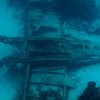
Wreck History:
The Beaufighter was introduced into Coastal Command as a strike fighter, where its gun armament was retained but rockets and torpedoes were added giving it an even greater fire power. The 5562 Beaufighters that were produced earned a considerable reputation in the Middle and Far East. After its withdrawal from operational use many Beaufighters were converted to target tug duties and in fact the last flight of the type in Royal Air Force service took place on 17 May 1960 when a TT10 made a final target towing flight from Seletar
Navigation:
900 metres offshore St Julian’s Point. The wrecks co-ordinates are of N 35’ 55.455 // E 014’ 30.189
Access: Boat Dive
Depth: 38 metres
Visibility: 10-20 metres
Sea Bed: Sand
Interests: Wreck Diver
Certification Required:
BSAC Sports Diver, PADI Advanced Open Water or equivalent
Wreck Statistics:
The aircraft lies upside down on a sandy bottom with the wings and centre fuselage still intact most of it buried in the sand. Both undercarriage frames and shredded tyres stick up from their wing position behind the engines. One of the propellers still intact to the engine partly buried.
On the 17 march 1943 the Beaufighter left Malta on a mission, but as soon as she left the airport mechanical problems led the aircraft to start vibrating and it began to lose altitude. The crew didn’t have much option but to ditch the plane in the sea, so as to salvage their lives.
“On 17th March 1943 at 1125 hours nine Beaufighters of No 272 squadron took off to escort nine Beauforts of No 39 Squadron on a shipping strike of Point Stelo. At 1138 hours Beau fighter ‘N,’ with Sgt Donald Frazee at the controls and Sgt Sandery as observer, began to vibrate violently and lost speed rapidly. There was no option but to ditch the aircraft and this was accomplished at 100mph in a slight swell about 1000 yards off Dragonara Point, Sliema. As all this took place close to shore, persons watching informed Fighter Control but Maltese dghajsas reached the crew some five minutes before rescue launch HSL 166 arrived on the spot. The air crew was transferred to the launch.